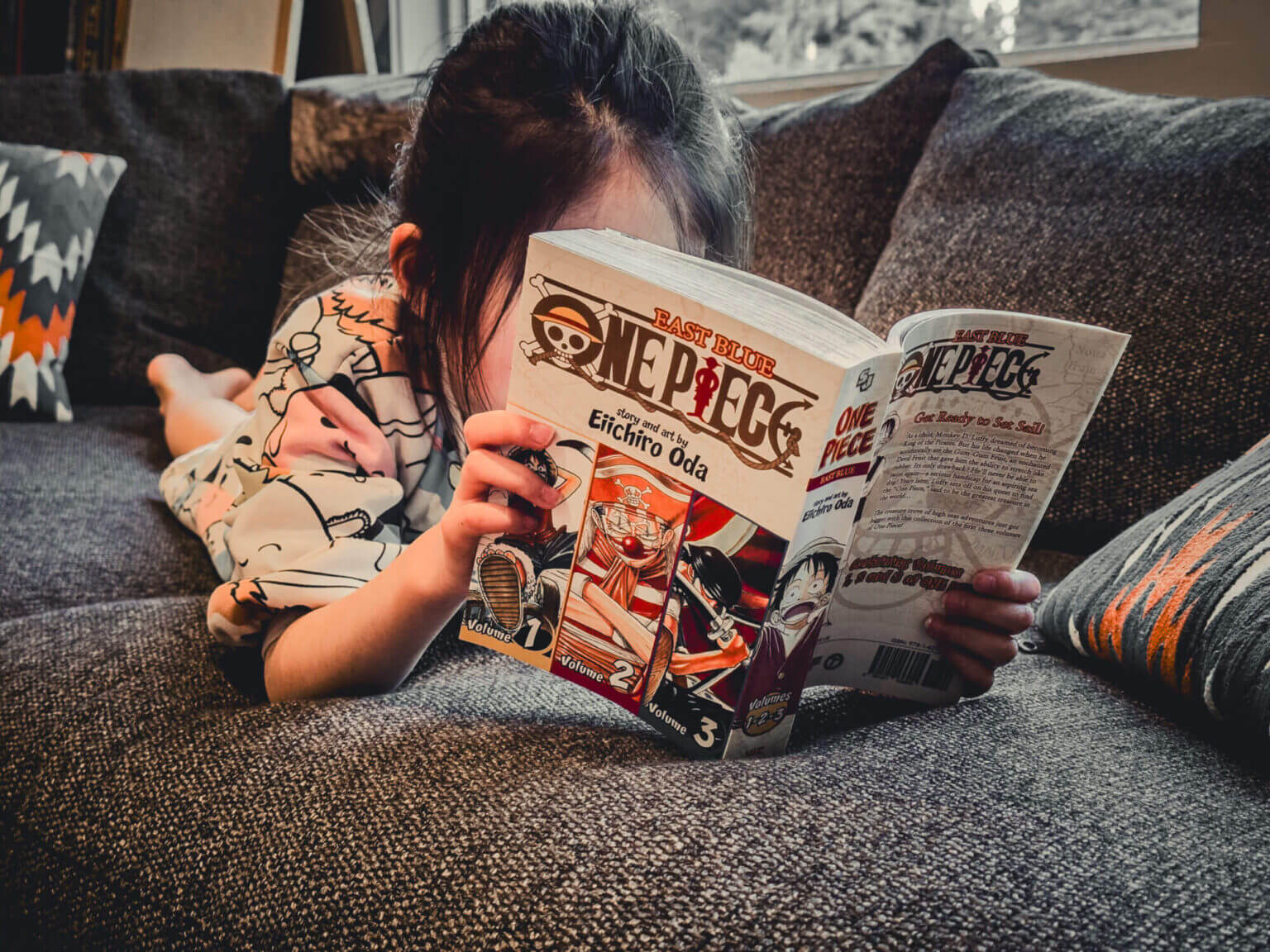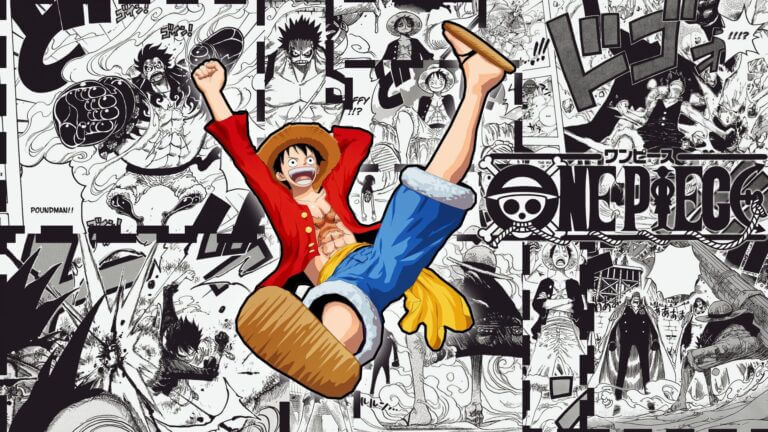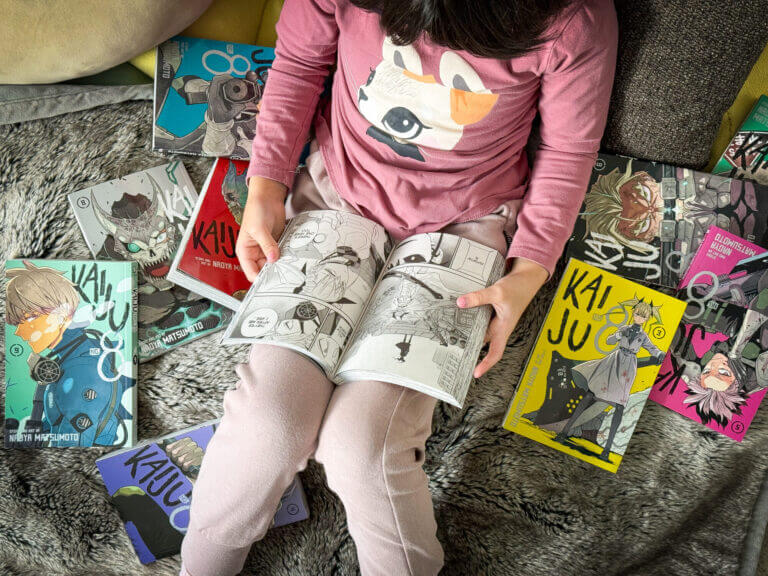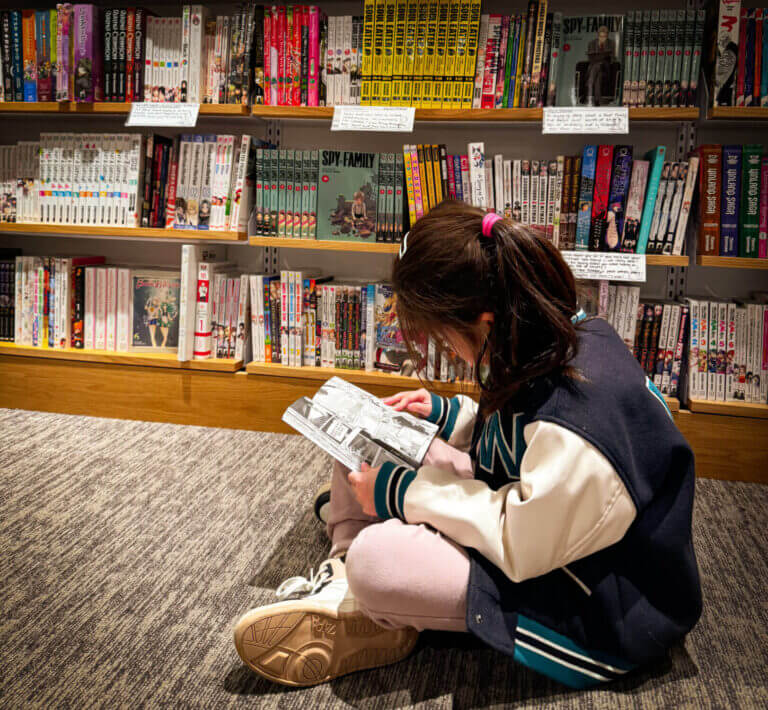If your son or daughter is curious about exploring the world of manga or anime, One Piece is an excellent starting point! Created by Eiichiro Oda, this globally beloved series has entertained fans for over two decades—and it’s even earned a spot in Amazon’s “Teacher’s Picks,” thanks to glowing feedback from educators who recognize its storytelling value.
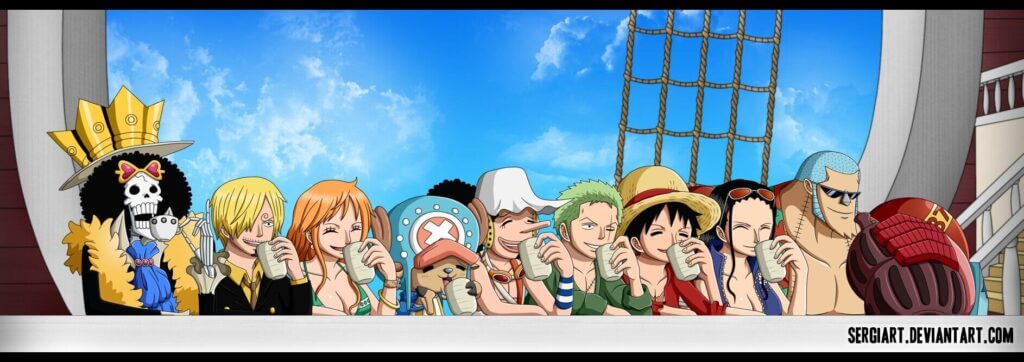
Whether your child is just getting into manga or already deep into pirate lingo and Devil Fruit debates, this One Piece parents guide is here to help. We’ll break down the One Piece plot, cover key arcs, give age-appropriate content insights, and share why this epic journey is more than just a goofy pirate adventure—it’s a tale about dreams, loyalty, courage, and found family that resonates with readers of all ages.
Table of Contents
Is One Piece Appropriate for Kids?
Age Recommendation: 9–12+
- Title: One Piece
- Story and Art: Eiichiro Oda
- Year Started: July 1997
- Age Recommendation: 10+
- Genre: Shonen, Action, Adventure, Fantasy, Comedy
*Our age ratings are based on our opinions and our daughter’s preferences, who reads above her age level. They’re meant as general guidance, but may vary and aren’t official standards.
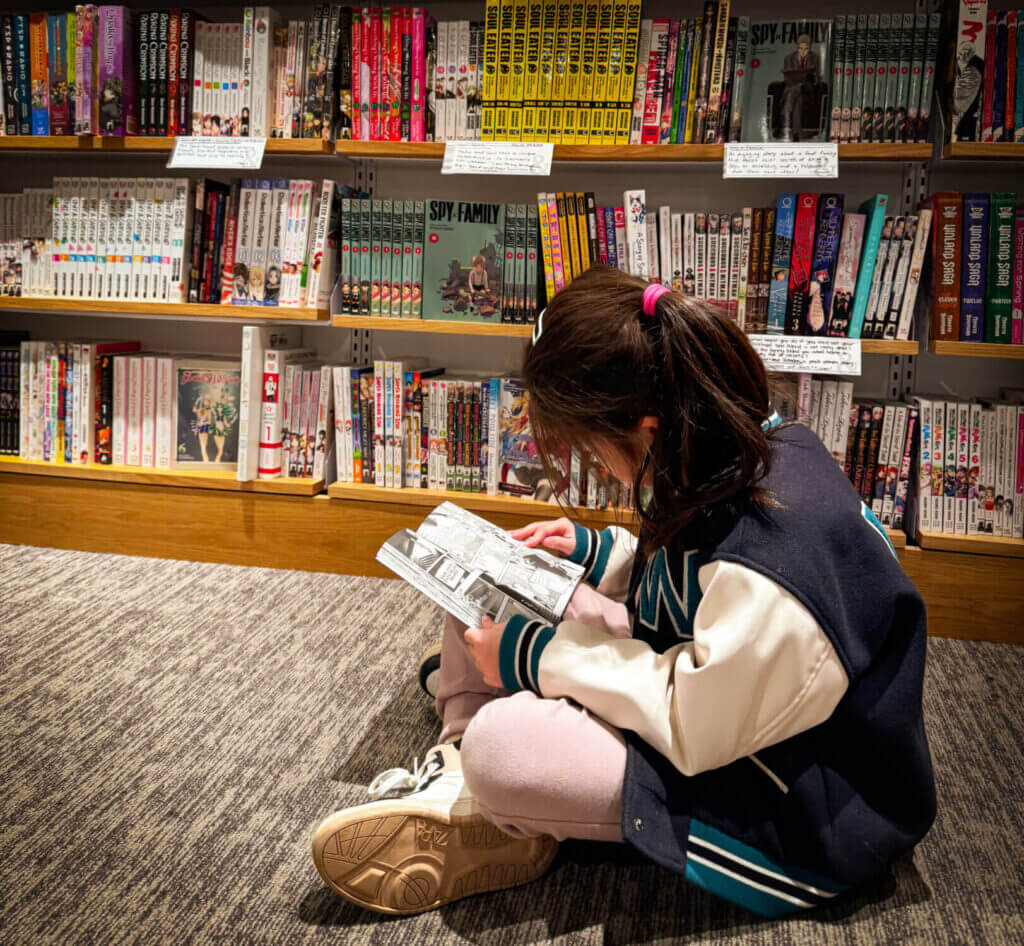
One Piece is generally safe for older elementary and middle school readers who are already comfortable with action-driven stories. The series includes cartoon-style violence, mild swearing, and the occasional innuendo or fanservice moment—but overall, it’s lighter than many shonen manga in tone.
As a One Piece parents guide, we recommend starting around age 10, though younger readers who enjoy action and humor (and are okay with some slapstick and fantasy violence) may be ready earlier. The core messages—persistence, friendship, and believing in yourself—are perfect for tweens.
Content Considerations for Parents
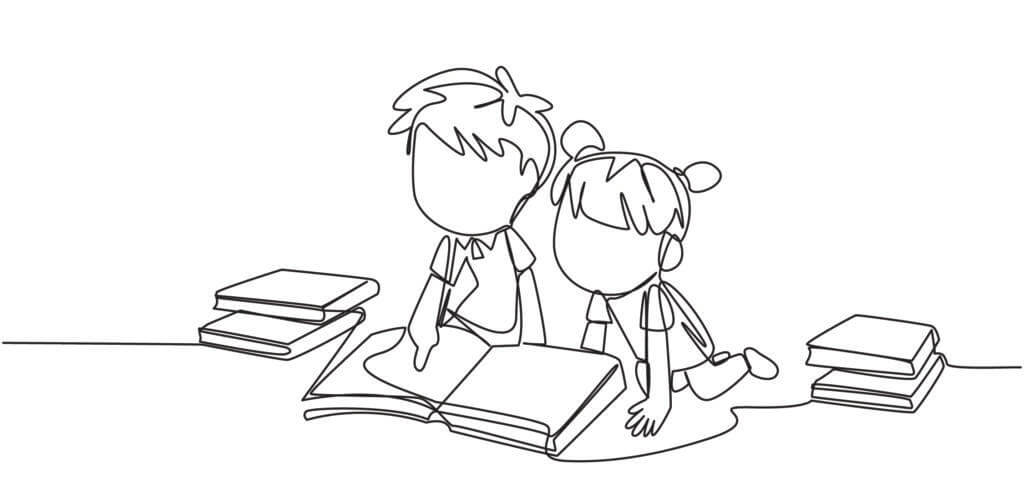
Violence and Action
As a pirate-themed series, One Piece does feature frequent fighting and fantasy violence. Expect lots of hand-to-hand combat, sword battles, superpowered attacks, and the occasional cannon blast or explosion. Characters do get hurt, and there are moments of tension involving executions or serious threats, but actual deaths are rare and usually handled with care.
While injuries and battle damage are common (you’ll see some blood, bruises, or bandages), the manga’s black-and-white art style softens the visual impact. It’s far from gory, and most violence is stylized or over-the-top in a cartoonish way—especially in the earlier arcs.
Parents should also be aware that some characters smoke or drink, which fits the rough-and-rowdy pirate setting but may warrant a quick conversation with younger readers.
Bottom line: For many tweens, the action is thrilling but not disturbing. If your child has already read series like My Hero Academia or Naruto, the tone and violence in One Piece will feel familiar and manageable.
Language and Swearing
Yes, One Piece includes occasional mild swearing—words like “shut up,” “crap,” and “damn” pop up now and then, especially during heated battles or comic arguments between characters. It’s not constant or aggressive, but it’s definitely present.
When I asked my elementary school daughter about these words, she shrugged and said, “I hear worse on the school bus.” That honest moment turned into a great opportunity for a quick conversation—about what’s appropriate language, how words can affect others, and why certain words might appear in fiction but shouldn’t be part of everyday talk.
So while the language might raise an eyebrow for younger readers, reading One Piece together can actually open the door to meaningful conversations about kindness, respect, and how characters express themselves under pressure.
Parent tip: If your child is sensitive to language or still learning when it’s okay to speak like a pirate and when it’s not, consider previewing a few chapters together first. Most families with tweens find the language mild and manageable.
Nudity & Fanservice
Like many long-running shonen manga, One Piece includes some light fanservice and mild nudity, mostly played for comedy. While there’s no graphic nudity, there are a few elements parents may want to be aware of—especially for younger or more observant readers.
Some female characters, particularly Nami and Robin, are drawn with exaggerated body proportions and revealing outfits, especially in later arcs. Bikini tops, short skirts, and midriff-bearing outfits are pretty common. In some storylines, clothing gets torn during battle, and there are running jokes around certain characters’ reactions to attractive women (usually Sanji, the crew’s flirty cook).
There are also a few moments where characters are seen in baths or changing clothes, but these are never explicit and often use well-placed objects or angles to keep things PG. My daughter barely noticed these scenes while reading, but I did take the opportunity to explain the difference between fantasy artwork and real-life expectations about bodies and modesty—an easy, age-appropriate conversation.
Parent tip: If you’re reading along with your child, you’ll likely spot these moments before they become an issue. For most middle-grade readers, they’ll either fly under the radar or be a good chance to have a light, respectful talk about media and character design.
Emotional Themes & Life Lessons
One of the most remarkable things about One Piece is how it delivers powerful emotional themes beneath the humor, action, and adventure. At its core, this series celebrates friendship, found family, pursuing dreams, and standing up for others—all values that resonate strongly with young readers trying to figure out their place in the world.
Luffy and his diverse crew of Straw Hat Pirates may come from wildly different backgrounds, but they support one another unconditionally. As a parent, I appreciate how One Piece consistently reinforces the idea that your character matters more than your background. Whether you’re rich or poor, human or fishman, royalty or runaway—the series highlights the worth of every individual. It quietly but firmly rejects racism, sexism, and discrimination through storytelling that’s both accessible and layered.
One Piece also introduces surprisingly mature concepts—justice, freedom, government corruption, systemic inequality, and moral ambiguity—without ever feeling too heavy-handed. It shows kids that the world isn’t black and white, and that doing what’s right often means asking hard questions and listening to others’ perspectives. The Straw Hats frequently challenge corrupt systems, question authority, and fight for people who can’t defend themselves.
Some of these ideas flew over my head when I was younger, but rereading them now with my daughter has brought a whole new level of meaning. It’s sparked conversations we didn’t expect to have during a “pirate manga”—and that’s what makes One Piece so special. It grows with your child and offers wisdom in the disguise of wild adventures and slapstick humor.
Parent tip: If you value stories that encourage empathy, resilience, and emotional intelligence, One Piece is a goldmine.
From Childhood Laughter to Deeper Lessons
One Piece has a special way of growing with its audience. What makes an elementary schooler laugh today might bring a parent pause tomorrow.
Take one of the earliest scenes in the first volume: my daughter couldn’t stop laughing when Luffy picked up a rice ball from the dirt and fed it to Zoro, who was tied to a post. Classic kid humor—messy food, exaggerated reactions, and a goofy main character doing something ridiculous.
But for older readers, this moment carries real emotional weight.
That rice ball was made by a little girl as a thank-you gift after Zoro protected her from some bullies at a corrupt naval base. When she tries to give it to him, the arrogant son of the base commander snatches it, insults her, and crushes it underfoot. After she’s chased away in tears, Zoro—still bound and unable to move—asks Luffy to feed him the trampled rice ball. He eats it with visible discomfort but insists Luffy tell the girl it was delicious.
That small act of kindness leaves a lasting impression on Luffy, who sees Zoro not just as a strong swordsman, but as someone with integrity and heart—someone worth having as a crewmate.
It’s a moment that lands differently depending on your age. Kids might see the silliness. Teens and adults will see the empathy, honor, and quiet rebellion against cruelty. One Piece is filled with scenes like this—layered, funny, and surprisingly moving.
Final Thoughts for Parents
One Piece is more than just a fun pirate adventure—it’s a story about resilience, friendship, and chasing your dreams. With its diverse cast and layered themes, it offers plenty of positive takeaways for kids and adults alike.
That said, the series does include stylized violence, occasional fanservice, and mature emotional themes. For that reason, it’s best suited for older kids who can tell the difference between fantasy and reality.
Every child is different, so we recommend previewing the content or watching/reading it together. A little parental involvement goes a long way—whether it’s answering questions, sharing a laugh, or having deeper conversations sparked by the story.
The One Piece Plot
The One Piece plot starts with a simple dream—Monkey D. Luffy wants to become the King of the Pirates—but that goal launches one of the most imaginative and beloved stories in manga history. What begins as one boy setting sail with a straw hat quickly expands into a sprawling adventure across a world full of sky islands, underwater cities, desert kingdoms, haunted ships, and futuristic islands powered by science.
Each new location brings a fresh storyline, unique culture, and deeper mysteries—like the origin of Devil Fruits, the truth behind the World Government, and the legendary treasure known as “One Piece.” These story arcs are action-packed and fast-paced, but also full of heart, humor, and lessons about friendship, freedom, and doing what’s right.
What makes our daughter love reading One Piece is the humor and silliness—Luffy and his crew are always getting into outrageous situations, cracking jokes, or overreacting in the funniest ways. She especially loves the mix of engaging action and lovable characters, including Chopper, a small talking reindeer who’s both adorable and brave, and Sanji, the crew’s dramatic cook who gets literal heart eyes every time he sees a girl (a detail she finds hilarious as a girl herself!).
With its balance of laugh-out-loud moments, fast-paced fights, and deep emotional arcs, One Piece keeps readers of all ages hooked. It’s a series that rewards curiosity, encourages imagination, and shows kids that even the wildest dreams are worth chasing.
How to Buy One Piece: What Parents Should Know
With a series as long-running as One Piece, figuring out the best way to start can be a little tricky—especially with over 100 volumes and counting! Here’s a quick breakdown of the different ways to buy and enjoy One Piece, depending on your child’s reading habits and your family’s preferences:
📘 Single Volumes
These are the standard editions, each containing about 9–10 chapters. They’re numbered in order and easy to collect one by one. Great if your child wants to try the series gradually, or if you’re picking up books here and there.
📙 Omnibus Editions (3 in 1 books)
Omnibus books bundle three volumes into one larger edition, making them more affordable and space-saving. This is how we personally started our collection. It’s a great option for testing the waters—especially if you’re not sure how committed your child is yet.
📦 Box Sets
After seeing how much our daughter loves the story, we realized the box sets might have been the better choice from the beginning. Each box set contains around 20–25 volumes, usually at a significant discount, and comes in a collectible case with bonus extras like posters or booklets. Perfect for passionate fans and makes an awesome gift.
📱 Digital (Shonen Jump App)
For just $2/month, the Shonen Jump app gives you access to One Piece and hundreds of other manga. It’s ideal for reading on tablets or phones, especially if you’re short on space or want to test out the series before buying physical books. We still use this when we’re on the go or waiting for the next box set.
Parent tip: If your child is already hooked and re-reading arcs, we’d recommend starting with the box sets. But if you’re easing into the manga world, omnibus or digital versions are a smart place to start. Either way, there’s no wrong path—just lots of adventure ahead!
What is a Devil Fruit?
One of the most exciting and unique parts of the One Piece world is the concept of Devil Fruits. These mysterious fruits grant incredible powers to anyone who eats them—but there’s a catch!
Each Devil Fruit gives the eater a specific ability, like turning into fire, stretching like rubber, creating ice, or even transforming into animals. Luffy, the main character, ate the Gum-Gum Fruit, which made his body stretchy like rubber—perfect for comedic chaos and surprise attacks.
Power and Price
But here’s the downside: anyone who eats a Devil Fruit loses the ability to swim, which is a pretty big deal when you’re living in a world of pirates and ocean travel. It’s a fun twist that creates tension, especially during water-based battles or rescues.
Unique Characteristics
Devil Fruits are not only unique in the powers they grant but also in their lifecycle and limitations:
One Power Per Person: An individual can only consume one Devil Fruit in their lifetime. Eating a second Devil Fruit is fatal, emphasizing the importance of the choice one makes.
Rebirth of Powers: Upon the death of a Devil Fruit user, the power reincarnates into another fruit somewhere in the world, continuing the cycle of mystical abilities.
Mystery and Lore: The origins of Devil Fruits are shrouded in mystery, even within the expansive lore of “One Piece.” They have been around for at least 800 years, contributing to many historical events and legends in the series.
Three main types of Devil Fruits
- Paramecia – grant superhuman abilities (like Luffy’s rubber powers)
- Zoan – allow the user to transform into animals (like Chopper, who becomes a talking reindeer!)
- Logia – let the user control natural elements (like fire, smoke, or ice)
Parent tip: Kids love discovering the creative powers tied to different Devil Fruits, and guessing what new ability will show up next. It adds a layer of magic and unpredictability that keeps the story fresh and fun.
Meet the Crew: A Parent’s Guide to the One Piece Characters Kids Will Love
One of the biggest reasons One Piece has remained a favorite for over two decades is its incredible cast of characters. The heart of the story lies with the Straw Hat Pirates, a diverse and dynamic crew led by the ever-optimistic Monkey D. Luffy. Each crewmate has a unique backstory, personal dream, and moral compass—making this group more than just shipmates. They’re a chosen family, and their bond is what makes the One Piece plot so engaging for readers of all ages.
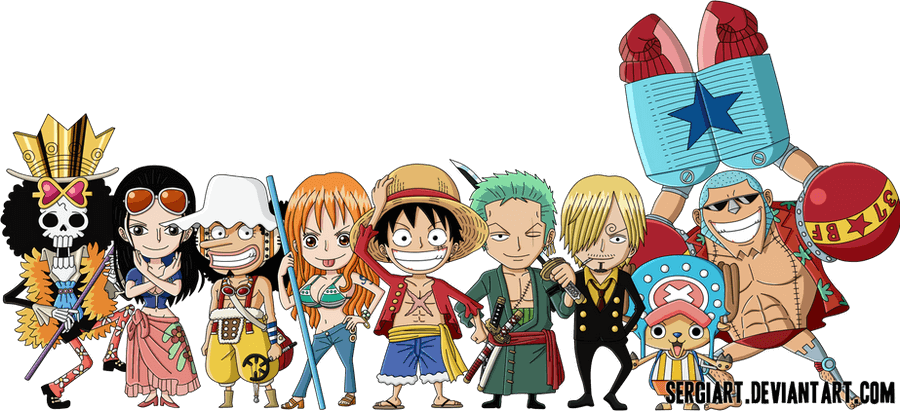
Our daughter loves the Straw Hats not just for their powers, but for their personalities—from Luffy’s wild ideas to Chopper’s cuteness and Sanji’s over-the-top “heart eyes.” Their funny moments, teamwork, and growth are what keep kids hooked and asking for “just one more chapter.”
Here’s a quick intro to the main One Piece characters and what makes each one stand out:
⭐ Monkey D. Luffy – The Rubber-Bodied Captain
Luffy is everything kids love in a main character—hilarious, fearless, loyal, and just the right amount of weird. He’s the kind of hero who’ll make your child laugh one minute and inspire them the next.
The Rubber Powers (and Their Price)
At age 7, Luffy accidentally ate the Gomu Gomu no Mi, a Paramecia-type Devil Fruit he found in a chest belonging to the Red Hair Pirates. That one bite turned his body into rubber—he can stretch, twist, bounce, and inflate like a living cartoon.
The catch? He lost the ability to swim—not ideal for a future pirate.
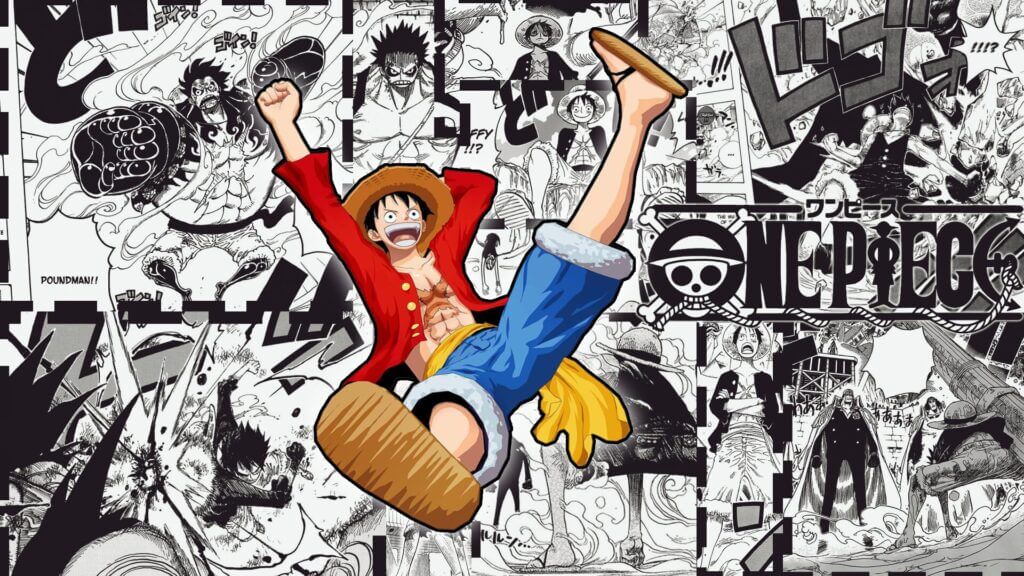
Setting Sail at 17
Ten years later, Luffy sets off at age 17 to become King of the Pirates. What follows is an epic journey as he assembles a crew of misfits, each with big dreams and painful pasts. Luffy’s unshakable belief in his friends is what keeps the Straw Hat crew together.
He doesn’t care about gold or glory—he values freedom, loyalty, and doing what’s right, even when it means breaking the rules.
Goofy but Grounded
Luffy is a blend of cartoonish goofball and deeply grounded leader. One minute he’s stretching his face and cracking jokes, the next he’s risking his life to protect a friend. He’s not the smartest guy on the ship—but his emotional intelligence, sense of justice, and pure-hearted drive make him a powerful role model.
Goofy but Grounded
Luffy’s simplicity hides a deep moral core. He stands for kindness, empathy, courage, and never giving up—not just for himself, but for others. He’s the kind of leader kids look up to without even realizing just how much he’s teaching them along the way.
⚔️ Roronoa Zoro – The Three-Sword Swordsman
Zoro was the first to join Luffy’s crew, and he’s been their strong, silent anchor ever since. Famous for his three-sword fighting style—yes, he really holds one in his mouth—Zoro’s goal is to become the world’s greatest swordsman, a promise he made to a childhood friend who inspired him.
Loyalty, Honor, and Quiet Strength
Though Zoro often seems stoic or gruff, he has one of the strongest moral compasses in the entire series. He follows Luffy not just as a captain, but as someone he genuinely respects—even declaring he’d rather die than let Luffy’s dream fail. His quiet loyalty and fierce integrity are part of what make him such a powerful figure.
Why Kids Love Zoro
Zoro’s epic battle scenes, cool-headed attitude, and sword skills make him a hit with kids. Older readers often admire his discipline, calm confidence, and the emotional weight behind his silent strength. And of course, there’s his terrible sense of direction—a running joke that provides great comic relief.
Parent Tip
Zoro is a wonderful example of dedication, perseverance, and standing up for what’s right—even when no one else is watching. He’s a great character to reference when talking to kids about inner strength, self-control, and staying true to your word.
🧭 Nami – The Clever Navigator
Nami is the brains of the Straw Hat crew, serving as their brilliant navigator. Her dream is to chart a complete map of the world, a goal rooted in her tough childhood and deep love of exploration. With sharp instincts, weather-reading skills, and pure sea savvy, she’s the one keeping the crew alive and on course.
A Past That Shaped Her
But Nami is more than her maps. One of the earliest emotional arcs in One Piece—her tragic past with the Arlong Pirates—shows just how much she’s endured. Her strength, sacrifice, and eventual rescue by Luffy is a major turning point, cementing her bond with the Straw Hats and showing her fierce loyalty.
Why Our Daughter Loves Nami
Our daughter adores Nami—not just because she’s smart, stylish, and strong, but because she’s the one who keeps Luffy in check. One of her favorite running jokes is when Nami punches Luffy for being too silly or reckless. These “tough love” moments are both hilarious and iconic, and show Nami’s role as both heart and backbone of the crew.
Parent Tip
Nami shows that courage doesn’t always mean charging into battle. Sometimes it’s about speaking up, trusting others, and being the calm in the storm. She’s a fantastic role model for intelligence, independence, and emotional strength—wrapped into one powerful heroine kids can look up to.
🎯 Usopp – The Storyteller Sniper with a Big Imagination
Usopp is the Straw Hats’ sniper, gadget-maker, and go-to tall-tale teller. When we first meet him, he’s full of outrageous stories and exaggerated bravery—but underneath it all is a kind, loyal boy trying to become someone strong enough to protect his friends.
His Dream: A Brave Warrior of the Sea
Usopp’s dream is to become a brave warrior of the sea, like his father Yasopp, who serves as a sniper for Shanks’ Red Hair Pirates. While Usopp isn’t the strongest, he’s incredibly resourceful, using handmade weapons, trick gadgets, and fast thinking to survive battles and support the crew.
Why Kids Love Usopp
Our daughter especially enjoys Usopp’s constant overreactions, wild monologues, and cartoon-style panic. He’s hilarious, dramatic, and full of charm—but what’s most inspiring is watching his confidence slowly grow as he learns to believe in himself.
From Scaredy-Cat to Courageous Crewmate
Usopp’s growth is one of the most relatable arcs in One Piece. He doesn’t start off brave—but through setbacks, training, and heartfelt moments, he becomes someone his powerful crewmates can count on. His bravery is rooted in persistence, not perfection.
Parent Tip
Usopp is a wonderful role model for showing that courage isn’t the absence of fear—it’s taking action despite it. He’s especially encouraging for kids who might not see themselves as the strongest, but want to grow into someone dependable, clever, and brave in their own way.
🍳 Sanji – The Chivalrous Chef with a Fiery Kick
Sanji is the cook of the Straw Hat Pirates—but don’t let the apron fool you. He’s also one of their strongest fighters, using a unique martial arts style that relies entirely on kicks (he refuses to use his hands in combat to protect them for cooking). His dream? To find the All Blue, a legendary sea said to contain every fish from every ocean—a chef’s paradise.
Flirty, Fancy, and Fiercely Loyal
Sanji is elegant, dramatic, and famously flirty. He swoons over every woman he meets—complete with hearts for eyesand over-the-top declarations of love. Our daughter finds this hilarious, especially when he turns into a cartoon prince around Nami or Robin.
More Than a Loverboy
Behind the romantic antics is a deeply complex character. Sanji’s backstory—especially in the Baratie and Whole Cake Island arcs—reveals a painful childhood, intense personal pride, and a powerful commitment to feeding anyone in need, even enemies. His strength isn’t just physical—it comes from his compassion and conviction.
Loyalty That Runs Deep
Sanji is one of the most self-sacrificing members of the crew. He’s often the first to throw himself in harm’s way to protect his friends—even if they don’t know it. His constant bickering with Zoro hides a foundation of mutual respect and trust.
Parent Tip
Sanji is a great example of chivalry, kindness, and discipline. He’s also a helpful character for discussing boundaries and respectful behavior with kids. His intense sense of honor and willingness to stand up for others make him a fun and meaningful part of the Straw Hat crew.
🦌 Tony Tony Chopper – The Adorable Reindeer Doctor
Tony Tony Chopper might be the most adorable Straw Hat—but don’t let the fuzzy hat and blue nose fool you. He’s also the crew’s doctor, a brilliant medical mind with a big heart and a bigger dream: to find a cure for every disease in the world.
Reindeer with a Human Heart
Chopper is a reindeer who ate the Hito Hito no Mi, a Zoan-type Devil Fruit that gave him human speech, intelligence, and the ability to walk upright. Thanks to his transforming powers, Chopper can switch between multiple forms—from a tiny plush-sized version to a towering, muscle-packed fighter.
He’s both the crew’s healer and an unexpected powerhouse in battle.
Silly, Sweet, and Lovably Dramatic
What makes Chopper especially lovable for younger readers is his childlike curiosity, emotional honesty, and his tendency to completely overreact—especially when complimented. His signature bashful catchphrase,
“Don’t flatter me, you jerk!”
(while spinning with sparkles) is a favorite in our house.
Our daughter adores him—not just because he’s cute, but because he’s brave in his own way and always wants to help his friends.
A Backstory About Belonging
Chopper’s past is one of the most touching in One Piece. Rejected by both reindeer and humans, he was taken in by a quirky but kind doctor who taught him that being different is a gift. His journey is all about acceptance, purpose, and self-worth—a message that hits home for kids who may feel out of place.
Parent Tip
Chopper is a wonderful character for starting conversations about kindness, confidence, and what it means to belong. He’s especially inspiring for kids who feel different, shy, or unsure of their strengths. And let’s be honest—he’s just really fun to watch.
📜 Nico Robin – The Quiet Scholar Who Seeks the Truth
Nico Robin brings a calm, mysterious energy to the Straw Hat crew—as well as one of the most emotionally rich and intellectually fascinating arcs in the entire One Piece plot. She’s an archaeologist with a tragic past, a sharp mind, and a quiet sense of humor that sneaks up on you when you least expect it.
Her Power: Hana Hana no Mi
Robin ate the Hana Hana no Mi, a Paramecia-type Devil Fruit that allows her to sprout her limbs—arms, legs, even eyes—on any surface. It’s a power that’s both extremely useful in battle and wildly imaginative for young readers.
Her Goal: Discovering the True History
Her dream is to discover the truth behind the mysterious Void Century, a lost chapter of world history that the oppressive World Government has worked hard to erase. To do that, she must locate and decipher the Rio Poneglyph, an ancient stone that holds the true history of the world.
A Tragic Past and a Turning Point
Robin’s story carries a lot of emotional weight—she was branded a criminal as a child simply for seeking knowledge and spent most of her life on the run, never able to trust anyone. Her heartbreaking catchphrase—“I want to live”—comes at a powerful turning point in the series when she finally chooses to believe in the Straw Hats and ask to be saved.
Why Our Daughter Finds Likes Her
Our daughter finds Robin intriguing, especially because she’s different from the other louder, more energetic crew members. She’s thoughtful, graceful, and always reading, but when the moment calls for it, she’s can also fight in battle.
Parent Tip
Robin is an ideal character for older tweens and middle school readers. She opens the door to themes like justice, censorship, loneliness, and the importance of preserving history, all while being a quiet yet strong female role model who grows more open and emotionally expressive with each arc.
🔧 Franky – The Loud, Cola-Fueled Cyborg with a Heart of Gold
Franky is the One Piece crew’s eccentric shipwright—a half-man, half-machine powerhouse who built the Thousand Sunny from the legendary Adam Wood. He’s a brilliant mechanic, a flamboyant performer, and a cyborg who literally runs on cola. Yes, he drinks soda to power his body—and it’s just as wild and hilarious as it sounds.
Personality: Big, Flashy, and SUPER!!!
Franky isn’t just smart—he’s a walking, shouting, posing explosion of personality. He has cannons in his arms, shoots lasers, and delivers some of the most over-the-top moments in the series. He’s loud, emotional, and always ready to strike a pose while yelling his signature catchphrase: “SUPER!!!”
Why Our 3-Year-Old Thinks He’s Hilarious
Our youngest daughter (age 3) absolutely adores Franky—even though she’s not old enough to read the story. She peeks over her big sister’s shoulder and giggles every time he appears. Why? In her words: “He wears panties!” (Franky’s tiny speedo and open shirt are part of his unforgettable comic charm.)
A Deeper Story Beneath the Laughs
Under the flashy design and comic relief is a meaningful backstory. Franky was once an outlaw shipbuilder, haunted by loss and guilt. His eventual decision to join the Straw Hats is deeply emotional—and watching him build his dream shipand sail with his chosen family is both powerful and heartwarming.
Parent Tip
Franky brings big laughs and bigger energy, but also delivers lessons in found family, forgiveness, creativity, and self-worth. He’s a wonderful character for kids who love chaos—but he also shows that even the loudest, silliest heroes can have the biggest hearts.
🎶 Brook – The Soulful Skeleton with a Violin and a Dream
Brook is the One Piece crew’s musician, and yes—he’s a living skeleton. With a top hat, cane sword, and an endless supply of puns, Brook brings both laughter and surprising emotional depth to the Straw Hat Pirates.
The Yomi Yomi no Mi: A Soul Returned
Brook gained his skeletal form after eating the Yomi Yomi no Mi, a Devil Fruit that allowed him to be resurrected after death. While his soul took too long to find his body, it had decayed into bones by the time he returned—giving him his iconic bony appearance. Despite his spooky look, Brook is full of life. He’s cheerful, polite, goofy, and endlessly entertaining, often asking, “May I see your panties?” in the most gentlemanly tone possible—a running joke that flies over younger kids’ heads but gives older fans a chuckle.
A Promise That Never Died
But beneath his silly antics is a truly touching story. Brook spent decades alone on a ghost ship after his crewmates died, clinging to the hope that he would one day reunite with Laboon, a whale he promised to see again. That promise drives his dream—and when the moment finally comes, it’s one of the most emotional payoffs in the One Piece plot.
Why Kids Love Brook
Kids are drawn to Brook for his fun skeleton design, wacky behavior, and musical flair—he performs with a violin or electric guitar, depending on the scene. He brings lightness to heavy moments and often surprises with how much heart he really has.
Parent Tip
Brook might seem like comic relief at first, but his story opens the door to conversations about grief, loyalty, resilience, and joy after loss. He’s a reminder that even those who’ve felt alone can find family again—and that laughter doesn’t mean you’ve forgotten the people you’ve lost.
🌊 Jinbe – The Honorable Helmsman
Jinbe is the Straw Hat Pirates’ helmsman, a master martial artist, and one of the most respected characters in the One Piece world. As a fish-man, Jinbe brings with him not only incredible strength and ocean-based skills, but also a powerful backstory rooted in themes of injustice, discrimination, and healing—making him a deeply meaningful figure for both kids and parents.
A Past with Purpose
A former member of the Sun Pirates, Jinbe once served under Fisher Tiger, a revolutionary figure who fought against the oppression of fish-men by the human world. After Fisher Tiger’s death, Jinbe continued working toward peaceful coexistence, eventually becoming a Warlord of the Sea and later aligning himself with Luffy—whom he sees as a true symbol of unity and hope.
Calm Strength and Quiet Mentorship
What makes Jinbe so compelling is his blend of stoic wisdom and gentle strength. He’s not flashy or loud, but when he speaks, people listen. He mentors Luffy during some of his lowest points, helping him process grief and loss. That emotional support, especially from such a strong and calm presence, shows readers that real strength can be quiet, steady, and compassionate.
Why Our Family Loves Jinbe
Our family loves Jinbe for the weight he brings to the crew. He’s often the one balancing out chaos with calm reasoning—and when he steps into battle, his Fish-Man Karate and powerful water-based techniques are showstoppers. He’s also one of the most respectful and thoughtful characters, often modeling emotional intelligence, patience, and integrity.
Why Our Family Loves Jinbe
Jinbe’s dream is to fulfill Fisher Tiger’s wish for equality and mutual understanding between humans and fish-men, making his role in One Piece especially important as the story delves into larger themes of societal structure and historical trauma.
Parent tip: Jinbe offers a beautiful example of bridging cultural divides, leading with empathy, and standing tall in the face of prejudice. He’s a fantastic character for kids who are ready to explore more nuanced themes while still enjoying thrilling action and strong crew camaraderie.
Best One Piece Arcs for Younger Readers
If your child is new to One Piece and you’re wondering where to start. Or which arcs are the most age-appropriate—this section is for you. While the full series includes mature themes and intense battles, some early arcs are perfect for younger readers thanks to their humor, adventure, and lighter tone.
Here are some great starting points for elementary-aged kids or tweens:
East Blue Saga
Why it’s great: This is where it all begins! These early arcs introduce Luffy and his first crewmates in a fun, adventurous way. There’s action, yes—but nothing too scary or graphic. It’s full of slapstick humor, simple villains, and strong messages about dreams and friendship.
Watch out for: A few intense moments, like Zoro’s past or Nami’s village arc (Arlong Park), but overall this saga is very kid-friendly.
👉 Check out our other blog here for a full summary of the East Blue arc.
Little Garden (Part of Baroque Works Saga)
Why it’s great: Two silly giants having a 100-year-long duel? A prehistoric island full of dinosaurs? This arc is packed with fun and classic comic-book energy. Usopp shines here, making it especially fun for imaginative younger readers.
Watch out for: Some sneaky villain tactics, but nothing too heavy.
👉 Want to learn more? Read our summary of the Little Garden arc here.
Drum Island Arc (Chopper’s Introduction)
Why it’s great: This arc introduces Tony Tony Chopper, a reindeer doctor with a heart of gold. His origin story includes emotional moments but ends on a hopeful note. Kids often love Chopper’s transformation powers and kind personality.
Watch out for: Some sadness around Chopper’s mentor, but it’s handled thoughtfully.
👉 Read more about the Drum Island arc in our full arc guide here.
Parts of Whole Cake Island
Why it’s great: While the arc gets intense later, the earlier parts are full of silly, candy-filled visuals and talking food. Younger kids may enjoy scenes on Totto Land, where even the trees and pastries can talk.
Watch out for: Deeper into the arc, things get darker—so stick to the first half for younger viewers.
👉 Get the full Whole Cake Island arc summary in our blog here.
Egghead Island (Beginning Sections)
Why it’s great: This arc includes futuristic fun—robot dogs, teleporting shoes, and wild inventions! The tech and humor early in the arc can be fun and engaging for younger readers before the storyline escalates.
Watch out for: The later parts include more intense battles and political themes, so previewing is recommended.
👉 Curious about Egghead Island? We break it all down in our detailed arc post here.
One Piece Arcs – A Quick Guide for Busy Parents
With over 100 volumes and 1,000+ episodes, One Piece can feel overwhelming to dive into—but don’t worry! You don’t have to read every page to follow your child’s favorite pirate adventures. In fact, we’ve put together a helpful breakdown of the major One Piece arcs—what each one is about, why they matter, and how the characters grow along the way.
👉 For our full arc-by-arc summary, check out our other blog here as we dive into each storyline in order.
Final Thoughts – Sailing Toward the Grand Finale
As One Piece enters its final saga, each arc—from Punk Hazard to Egghead Island—has raised the stakes and brought the Straw Hat Pirates closer than ever to their ultimate goal. We’ve seen friendships tested, new alliances forged, and powerful enemies fall. But above all, we’ve watched Luffy and his crew grow—not just in strength, but in heart.
For families reading together, this is a powerful reminder that One Piece is more than just pirates and powers. It’s a story about dreams, resilience, loyalty, and standing up for what’s right, even when the world says otherwise.
As the adventure sails into Elbaf and beyond, now is the perfect time to catch up, talk with your kids about the themes they’re absorbing, and enjoy the ride together—because if there’s one thing One Piece teaches us, it’s that no one becomes king alone.
The final treasure might still be a mystery—but the journey? That’s always been the real reward.

